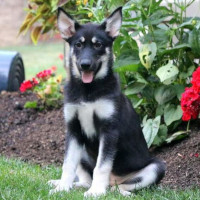Appearance of the Gerberian Shepsky
|
| In a word, the Gerberian Shepsky is beautiful. Having acquired the best physical attributes from both parents, this is a truly stunning-looking dog. Well-muscled and powerful, agile and athletic, the Gerberian Shepsky has a long, lean body. These dogs have relatively large heads with pointed muzzles and strong jaws. Their black noses are broad, with large nostrils. Their ears are particularly large and erect. While their alert eyes can be blue or brown, or one of each, breeders and owners have a preference for light blue eyes that contrast nicely with their dark faces. They can have a Husky-type tail that curls over the back, or a lower tail like that of the German Shepherd. Their soft fur is thick and offers ample protection from the outside environment. Although most dogs are a mixture of brown and black, their coats can be composed of several colors, including black, white, brown, blue, red and cream. Most dogs measure 50 to 61 cm at the withers. Their weight varies enormously from one individual to another, with dogs weighing between 22 and 40 kg. |
Temperament of the Gerberian Shepsky
|
| With parents that include a larger-than-life German Shepherd and a fiery, enthusiastic Siberian Husky, the Gerberian Shepsky will never lack for personality issues. Until this breed is better established, some individuals will resemble German Shepherds more, and others, the Siberian Husky temperament. Even in litters, there will be a variety of characters and traits. Until the dog is fully mature, it can be difficult to predict its nature, especially if it's a first-generation cross. The Gerberian Shepsky tends to be very energetic and always eager to live life to the full. Incredibly intelligent and aware, they also love to play and are loyal to their families. Dogs that draw more of their genetics from the German Shepherd side of the family will often be focused and disciplined, while those that inherit more of the Siberian Husky genes will be a little less obedient and more exuberant and clumsy. Most Gerberian Shepsky dogs greet new people suspiciously at home. However, some will be more reserved and stay away from newcomers. The majority of this breed is very sociable with the whole family, including children, and will form close bonds with those they spend the most time with. With the right socialization and as long as introductions are made early in life, most Gerberian Shepsky dogs will do well with other pets. Caution is advised, however, when prey, such as rabbits and guinea pigs, may be pursued and harassed. |
Needs and activities of the Gerberian Shepsky
|
| The Gerberian Shepsky loves action, and thrives on being busy. A bored dog will start to have behavioral problems, such as barking incessantly in your absence, which will drive your neighbors crazy, or chewing anything they please. They're ideal dogs to take for a run, or when you're out cycling, they can sneak alongside. They love to play ball chase, tug-of-war or any workout if it's interesting. If the activity is boring, your dog will lose interest and become a chore. Because of their activity level and tendency to bark, they are not suitable for apartment living. |
Maintenance of the Gerberian Shepsky
|
| The Gerberian Shepsky's beautiful coat needs brushing twice a week to keep it looking its best. Spend some of your time pleasantly combing through the coat and the soft inner layer. Only bathe him when he needs it, as you could strip the coat of its natural oils, which are both protective and give the coat its shine. Praise your dog for standing still and letting you examine his ears and eyes, trim his nails and let you brush his teeth. With this hybrid breed, it's essential to keep things interesting. They can get bored easily, so don't overdo the grooming, keep it as brief as possible and inject as much fun as praise and you'll get a beautiful, content dog. |









 English (United Kingdom)
English (United Kingdom)